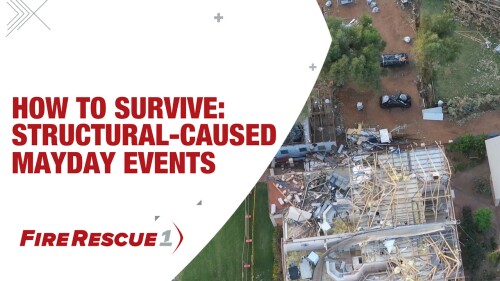By William L. Shagena
Mayday training at the recruit level is particularly challenging. How do you convey to recruits the seriousness of a mayday incident without instilling such fear in the job that they either exit the program or can’t complete their basic job duties?
It’s important to strike a balance. They must understand the hazards of the job, but they can’t avoid them either.
For trainers, it’s important to keep a few points in perspective: Recruits have no muscle memory related to how fireground operations unfold and therefore no context for how dangerous these situations are. On the flip side, some recruits might know too much – some of it perhaps even incorrect – about the dangers of fireground operations, and the thought of even training on mayday events makes them queasy.
Again, its about finding the right balance. They need to understand what constitutes a mayday and accept that training on mayday events is the best way to survive one.
Set the stage
At the recruit level, we like to imagine that most instruction occurs within the relative safety of an academy setting. However, in some areas, recruits get thrown into real-world operations quickly. For example, in my area of Michigan, our academy meets two nights a week and every other Saturday. When the cadets have passed all their testing, they are released and start running with their departments.
Recognizing this fast evolution from training to real-world experience, I like to begin by painting a picture for the recruits: The mayday event is one of the most crucial events they will ever face. They need to understand that maydays are not frequent occurrences, so it’s vital that they practice and prepare often back at the department. Underscore the importance of building muscle memory. Explain the physiological changes that occur, making it difficult to think clearly. That is when muscle memory matters. After all, when you’re not thinking clearly, your body will default to the training it knows.
It’s also important that recruits understand when to call a mayday. A mayday is more than just getting trapped in a building. It could involve getting lost, SCBA malfunction, losing your partner, losing your hoseline, any type of collapse, falling through a floor or downstairs, losing your tool, or even just getting overwhelmed.
A critical element to teach at this stage is to NOT delay when calling a mayday. The earlier the mayday is called, the more likely the chance for a successful outcome. This is also a good time to reinforce that a self-rescue can burn precious air supply. It’s best to call the mayday while you have plenty of air supply.
Get specific and use mnemonics
For recruits, start with the basics. That means following a simple process, starting with what to say:
- Repeat “Mayday, mayday, mayday!”
- Pause to make sure you get feedback from IC; this starts a chain of events at the IC level.
- Leave your radio stays on its current channel.
- Activate your PASS alarm on your SCBA.
- Give a LUNAR or LIPS report (more on this below).
- Stay calm. If you’re panicked, the IC and RIT team will likely be panicked, too.
Now’s the time to teach or reinforce the LUNAR and LIPS acronyms.
LUNAR is a standard mayday mnemonic:
- L = Location: Where are you in the structure? What way did you enter? Did you start a left- or right-handed search? Did you go up or down stairs?
- U = Unit: What company or department are you with?
- N = Name: State your name.
- A = Air supply: Share how much air supply you have left.
- R = Resources: What resources might be needed to help rescue you?
LIPS is a shorter version:
- L = Location: Advise command of your location.
- I = Identification: Share your name and department.
- P = Problem: Explain the problem you have encountered (low on air, lost, trapped, etc.).
- S = Survival: Quite simply, you survive the event.
Remind recruits that departments use different mayday protocols so it’s important that they follow the one practiced at their department – even if they prefer a different one or heard about a different one from a fellow firefighter at a different department.
Share bonus tips
You will likely have much more guidance to share beyond these basics – don’t hesitate to doll out advice to your recruits, even if the tips feel insignificant. Start small and build up. There is so much to share.
For example, here’s some of my beyond-the-basics guidance that could help with self-rescue or details to share with the IC:
- If you are in a room and you are crawling around and come across a heat register 90%, chances are there’s a window right above it. You will learn that in building construction class.
- If you come across bathroom items, you know the window will be higher, but you have access to water.
Practice, practice, practice
Maydays are high-risk/low-frequency events, which means we have to increase our muscle memory during training. We need to train, train and train some more to ensure you and your recruits know how to survive a mayday incident.
About the author
William L. Shagena is a captain with the Fort Gratiot Fire Department in Michigan. He has 34 years of fire service experience, with 10 years of experience focused on instruction.
This article, originally published on February 08, 2022, has been updated.














